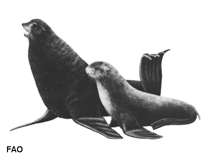Callorhinus ursinus (Linnaeus, 1758)
Northern fur seal| Native range | All suitable habitat | Point map | Year 2050 |

|
| This map was computer-generated and has not yet been reviewed. |
| Callorhinus ursinus AquaMaps Data sources: GBIF OBIS |
Classification / Names Populärnamn | synonymer | CoL | ITIS | WoRMS
Mammalia | Carnivora | Otariidae
Environment: milieu / climate zone / djupintervall / distribution range Ekologi
Djupbottenlevande. Subtropical; 90°N - 0°S, 180°W - 180°E
Distribution Länder | FAO områden | Ekosystem | Förekomster | Utplanteringar
Pacific Ocean and the Arctic.
Length at first maturity / Size / Weight / Age
Könsmognad: Lm ? range ? - ? cm Max length : 210 cm TL hane/ej könsbestämd; (Ref. 1394); 150 cm TL (female); publicerad maxvikt: 270.0 kg (Ref. 1394); publicerad maxvikt: 270.0 kg
Life cycle and mating behavior Könsmognad | Reproduktion | Lek | Eggs | Fecundity | Larvae
Main reference
referenser | Koordinator | Medarbetare
Jefferson, T.A., S. Leatherwood and M.A. Webber 1993 FAO species Identification Guide: Marine Mammals of the World. Rome, FAO. 320 p. + 587 figures. (Ref. 1394)
IUCN Red List Status
(Ref. 130435: Version 2025-1)
CITES status (Ref. 108899)
CMS (Ref. 116361)
Threat to humans
Human uses
Fiskeri: kommersiell
FAO - fiskeri: landings, species profile | FishSource | Sea Around Us
Verktyg
Ytterligare information
Max. ages / sizes
Length-weight rel.
Length-length rel.
Length-frequencies
Mass conversion
Abundans
Internet-källor
BHL | BOLD Systems | CISTI | DiscoverLife | FAO(fiskeri: species profile; publication : search) | Fishipedia | GenBank (genome, nucleotide) | GloBI | Gomexsi | Google Books | Google Scholar | Google | PubMed | Tree of Life | Wikipedia (Go, sök) | Zoological Record



